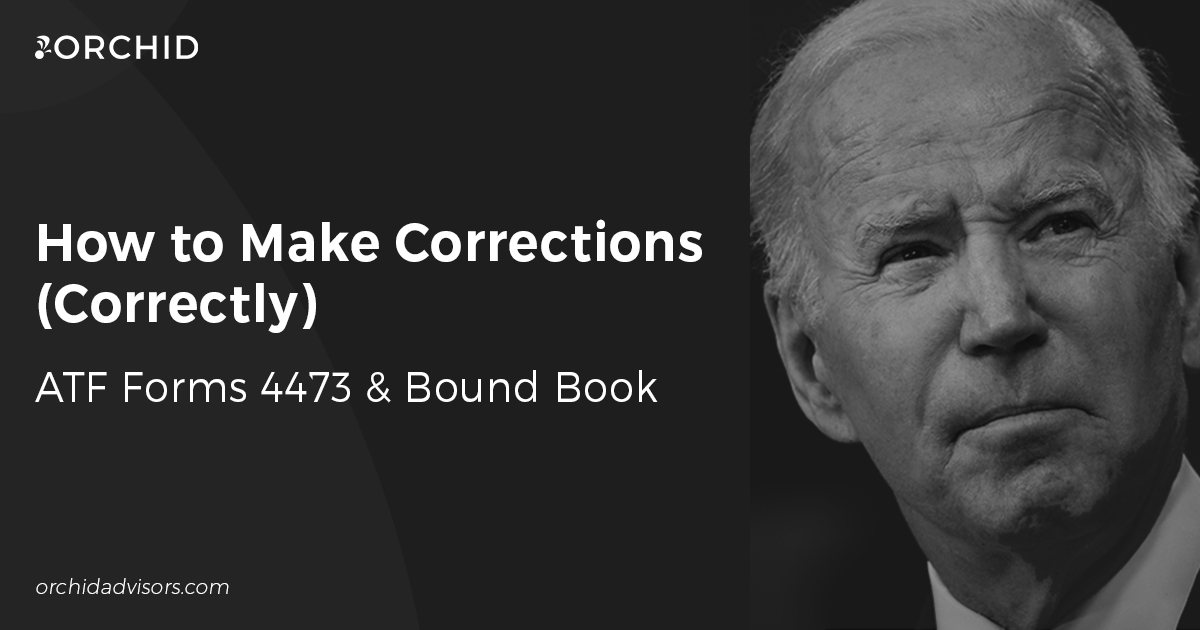Let’s face it – we all make mistakes. But let’s also admit some mistakes have worse consequences than others. For FFLs, those mistakes could cost firearm dealers and manufacturers their licenses, especially under the Biden administration’s zero tolerance policy and stricter ATF enforcement.
As a firearms retailer, you likely see mistakes multiple times every single day. No matter how many times you tell a customer completing an ATF Forms 4473 to take their time, read directions carefully, and review their answers, mistakes are inevitably made. And as a manufacturer, no matter how meticulous you are about your processes and recordkeeping, you’ll eventually make an error in you’re A&D bound book, misrepresenting a firearm’s model, caliber or type.
While mistakes are not to be desired, those made are also not without fixes. Most mistakes on Forms 4473s and in firearm logbooks can be corrected without incurring a violation, provided the correction is made correctly and in a timely fashion.
ATF Form 4473 Corrections
How to Make Corrections
Proper ATF Form 4473 corrections should include four steps:
- Draw a single line through the error
- Write or mark the correction in the box with the error
- Write initials in or near the box with the error
- Write the date the correction was made in or near the box with the error
Keep in mind errors could be entire answers or parts of a response. The date should also be written in a standard format and include the month, day and year (check with your local ATF Field Office or IOI for preferences). It’s also important to keep corrections, including the correct answer, initials and date, in the same box in which the error was made, if possible. Write small, but legible, and if more room is needed, corrections should be made as close to the box as possible.
Corrections should be made in pen (preferably black or blue ink) and never combined with the use of corrective fluid or tape (i.e., wite-out).
Buyer vs. Seller
Most Form 4473 mistakes are made by customers, but licensees also make their fair share. Regardless of who makes the error, the process of making a correction is the same. However, what differs is the party responsible for making the correction.
ATF regulation states the buyer/transferee should only make changes to Sections B and D of the 4473, correlating to the individual’s personal information, responses to prohibited questions, and recertification. Meanwhile, the licensee should only make changes to Sections A, C, and E on the form, representing the firearm(s) being transferred, provided customer identification, NICS/POC background check, and licensee certification.
Pre vs. Post-Transfer
ATF regulation is also strict regarding how a correction is made depending on when the mistake is discovered. If an error is found before the firearm has been transferred, the correction should be made on the original or first-printed paper form.
If an error is found after the firearm has been transferred, a photocopy of the specific page with the mistake should be made. The word “Copy” should be written in the top right corner of the form, the correction made to the copy, and the corrected copy attached to the original Form 4473 and retained in the licensee’s permanent records. Post-transfer corrections may require the buyer/transferee or licensee employee coming back in to make the correction.
Paper vs. Electronic
While most of today’s firearm dealers use electronic Forms 4473, some still choose to use paper versions of the form. Using an e4473 generally reduces customer and licensee errors, but mistakes can still be made that bypass even the best software.
If mistakes are made to an e4473 while a customer is still present, the form must be printed and corrected as a standard paper form would be, as electronic forms must be saved in an unalterable format, per ATF Ruling 2016-1. If the transfer has already been completed, corrections may be made to either a digital or paper copy of the form, per recent ATF Ruling 2022-1.
Forms initiated on paper should be corrected on the original paper form or a photocopy.
Bound Book Corrections
Paper vs. Electronic
Like Forms 4473, most FFLs today rely on an electronic bound book to track firearm acquisitions and dispositions. But, for many old school and smaller operations, paper logbooks are still in use. Unlike e4473s, though, the method in which corrections are made in paper and electronic bound books are different.
For paper A&D bound books, mistakes and errors should be corrected by the licensee just like a Form 4473:
- Draw a single line through the error
- Write or mark the correction in the box with the error
- Write initials in or near the box with the error
- Write the date the correction was made in or near the box with the error
For instances in which an entire firearm entry may be wrong, it’s recommended an additional note be made to provide context for the correction (e.g., duplicate firearm). Corrections should be made in pen (preferably black or blue ink) and never combined with the use of corrective fluid or tape (i.e., wite-out).
For electronic bound books, correction methods can vary depending on the software or application being used. However, ATF Ruling 2016-1 requires such technology track corrections and changes using one of three methods:
- The system must retain any correction as an entirely new entry, without deleting or modifying the original entry.
- The system must be able to print the corrections as a separate report containing the same parameters as are required for a paper bound book, including the firearm information, acquisition details, and disposition details.
- If a spreadsheet program (e.g., Microsoft Excel) is being utilized, the system must be able to track any edits/corrections/amendments in a “notes” column.
Whichever method, the correction or change must be maintained to allow for future reference. The correction entry, report or note should also include what was changed, who made the change, and why the change was needed.
Orchid Zero Tolerance Protection
At Orchid, our team of operations, technology and legal professionals understand the risks of today’s firearm businesses. For over a decade, we’ve worked with FFLs big and small to implement leading compliance best practices and software solutions to eliminate violations and protect licenses from revocation.
Continuing our Zero Tolerance Protection series, we’ll share our expertise and experience in proactive compliance as we look closer at Biden’s policy and its impact on the firearms industry, review how to avoid and correct violations, and suggest ways to protect your FFL from the risk of revocation. Next, we’ll discuss another willful violation, failing to respond to firearm trace requests.
In the meantime, learn more about a Zero Tolerance Rapid Assessment of prior ATF Reports of Violations, your A&D Bound Book, and recent ATF Forms 4473. We also encourage you to watch our webinar on ATF zero tolerance enforcement, schedule an in-person or remote mock ATF inspection, and implement leading compliance software in your retail FFL. Contact Orchid today to protect your FFL from a zero tolerance revocation.








0 Comments